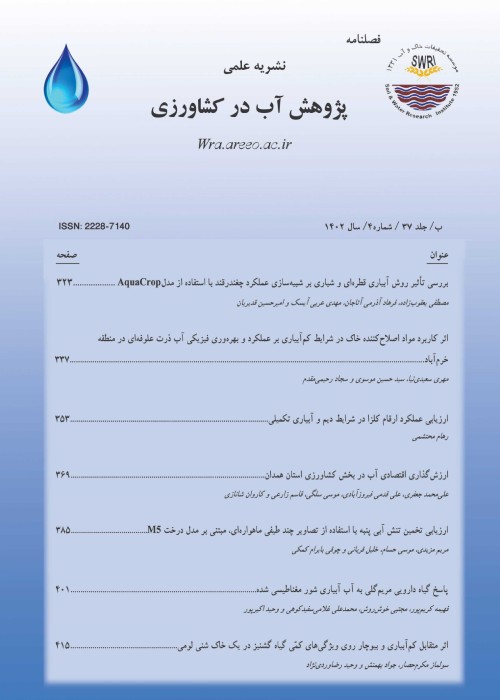Concentration of Lead and Chromium in Leaves of Cress and Parsley in Soils Irrigated with Contaminated Water
Author(s):
Abstract:
In order to investigate the effect of different amounts of lead and chromium accumulation in soils and vegetables (cress and parsley), an experiment was conducted in pots in the research greenhouse of Sari Agricultural Sciences and Natural Resources University, in 2011. The pots had a height of 22 cm and diameter of 28 cm, filled with loamy soil. The experiment had factorial arrangements based on randomized complete block design with three replications and sixteen treatments. Treatments consisted of four levels of lead in irrigation water (0, 500, 1000, 1500 mg l-1 of lead nitrate source (and four levels of chromium (0, 100, 200, 400 mg l-1 of chromium nitrate source), while treatments were studied as separate and combined. The correlation result showed that the application of different amounts of lead and chromium in water had significant effect on total and available concentration of lead and chromium in the soil. Increasing the amount of lead in irrigation water decreased the amount of chromium in surface soil and increased the amount of total and available lead in cress and parsley soil. Also, with increase in the amount of chromium in irrigation water and decrease in the amount of lead in combined treatments, the amount of total and available chromium increased. The result showed that with increasing the soil contamination by using a solution having 1000 mg l-1 Pb, lead concentration increased in shoot compared to the control and, at higher levels of contamination, lead concentration decreased in root. The reason might be the explained by saying that with increase in roots lead content, most probably, it deposited in root as insoluble compounds and did not transmit to the shoot. However, in the case of chromium, it is immobile due to remaining in the cation exchange sites and its tendency for hydrolysis and absorption. The chromium bond to hydroxyl groups on the roots cell walls prevents movement of this ionic form to shoots. The highest accumulated lead in vegetables shoot was in 1000 mg l-1 lead treatment and the highest accumulation of chromium in the studied vegetable shoots was in 400 mg l-1 chromium treatment. It is obvious that there are significant health risks in use of polluted water for irrigation of vegetable fields and fruit gardens. Contamination of these products has caused a dilemma that, according to health professionals, is a catastrophe.
Keywords:
Language:
Persian
Published:
Journal of Water Research in Agriculture, Volume:31 Issue: 2, 2017
Pages:
181 to 194
magiran.com/p1738217
دانلود و مطالعه متن این مقاله با یکی از روشهای زیر امکان پذیر است:
اشتراک شخصی
با عضویت و پرداخت آنلاین حق اشتراک یکساله به مبلغ 1,390,000ريال میتوانید 70 عنوان مطلب دانلود کنید!
اشتراک سازمانی
به کتابخانه دانشگاه یا محل کار خود پیشنهاد کنید تا اشتراک سازمانی این پایگاه را برای دسترسی نامحدود همه کاربران به متن مطالب تهیه نمایند!
توجه!
- حق عضویت دریافتی صرف حمایت از نشریات عضو و نگهداری، تکمیل و توسعه مگیران میشود.
- پرداخت حق اشتراک و دانلود مقالات اجازه بازنشر آن در سایر رسانههای چاپی و دیجیتال را به کاربر نمیدهد.
In order to view content subscription is required
Personal subscription
Subscribe magiran.com for 70 € euros via PayPal and download 70 articles during a year.
Organization subscription
Please contact us to subscribe your university or library for unlimited access!



